Medieval Wineglass Pulpit
Burnham Norton church close to the north coast of Norfolk has amongst its treasures a medieval wineglass pulpit. Perhaps this was used for the proclamation of the Gospel as well as for preaching and for 'bidding the beads'! The pulpit is notable in that it still has a substantial amount of it's medieval polychromy remaining, carefully restored in the twentieth century by Pauline Plummer. The subject matter of the panels is appropriate for an item of furniture used for preaching and teaching, on four of the six panels are images of the four Latin Doctors of the church: St Gregory the Great, St Ambrose, St Augustine and St Jerome.
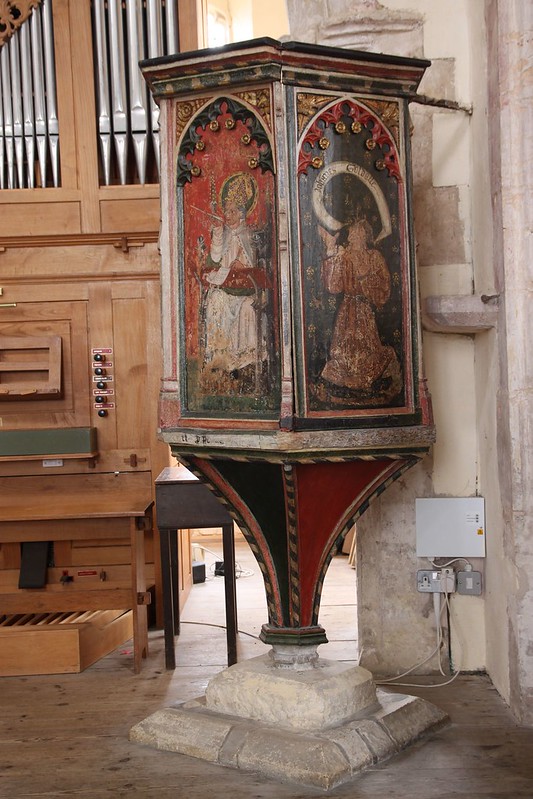
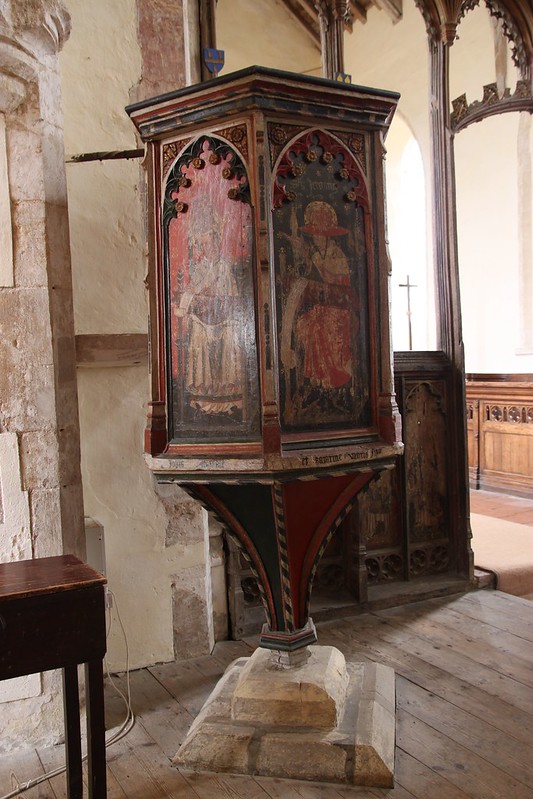
St Jerome is sat at his writing desk, dressed, as was usual in medieval depictions of him, the scarlet of a Cardinal with a broad brimmed cardinals hat on his head. He is working on a large scroll that hangs over the front of the desk. What he's doing is unclear as this panel is quite damaged, but he may be sharpening his quill with a knife. Notice that behind him the green coloured ground with a powdering of gold motifs. The pulpit, as is typical of late medieval polychromy uses counterchange to good effect.
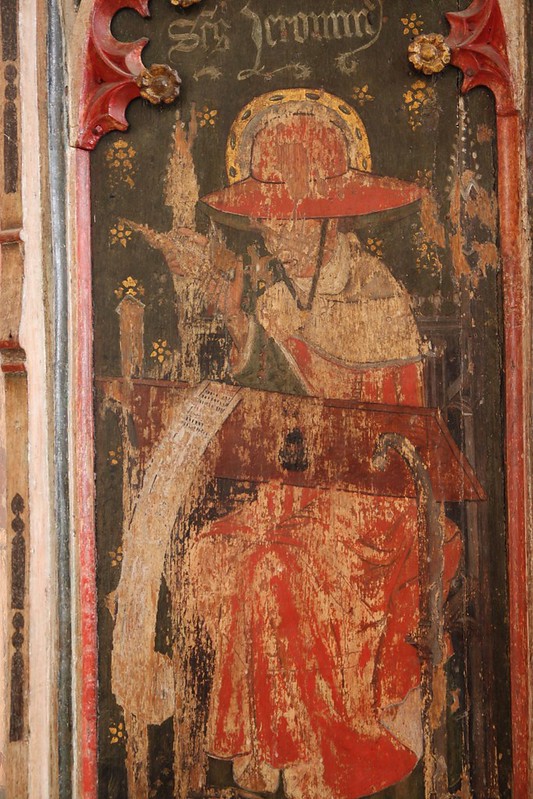
St Ambrose is dressed in the everyday dress of a medieval bishop, a fur lined and trimmed gown, with a mitre on his head. He has completed his text and seems to be contemplating the scroll it is written on. Notice the label above his head, written freehand and not lined out before application - it slants downwards.

Pope St Gregory the Great is similarly dressed. The papal tiara that once sat upon his head has been the victim of very thorough piece of iconoclasm and has be virtually obliterated by a Protestant fanatic. Mitres are one thing, but to tolerate the papal tiara was quite another. He is busy writing on his scroll, quill in one hand, knife in the other, ready to affect any corrections as he goes! Notice the counterchange here, the scarlet and gilded ground, contrasting with the green of the cusping of the arch that frames it.

Lastly St Augustine, perhaps the most lively of the four figures, his gaze is directed outwards. His is one of the centre panels and the one most clearly seen on the front of the pulpit. In one hand is his knife, in the other he has a stylus, it's as though we have interrupted him at his work and he has stopped either to rebuke us or to make a theological point.
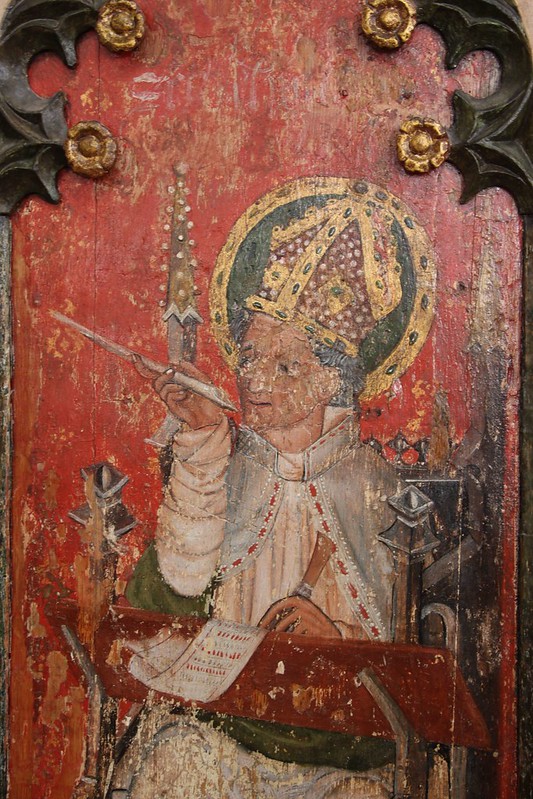
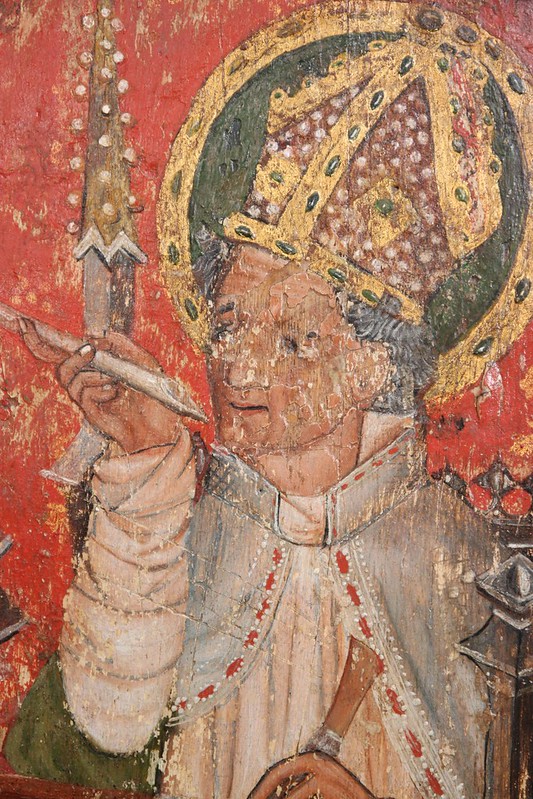
Around the base of the pulpit is an inscription asking for prayers for the soul of John and Katherine Goldalle, who had the pulpit made in 1450. And at the back of the pulpit, amid the exalted company of the Doctors of the Church, and with their hands open in adoration of the company they are keeping, are the kneeling donor images of John and Katherine themselves, neatly labelled.
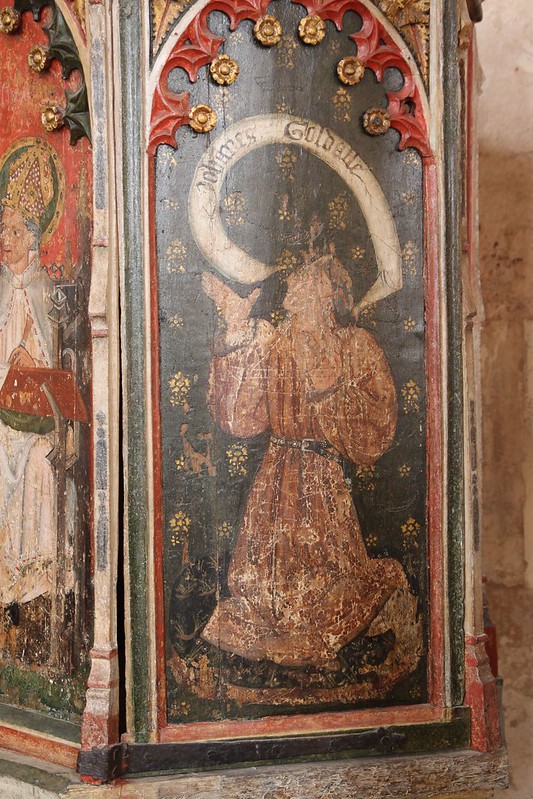
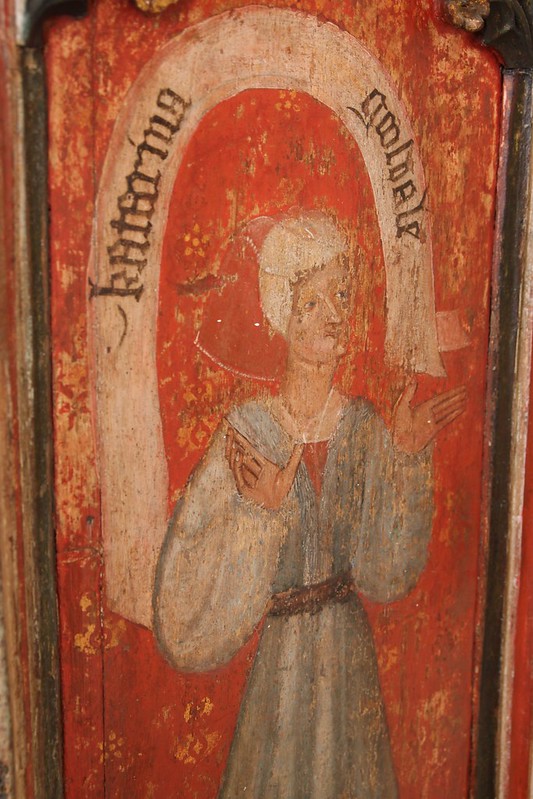
There is full set of images of the pulpit and of the rest of the church here.


St Jerome is sat at his writing desk, dressed, as was usual in medieval depictions of him, the scarlet of a Cardinal with a broad brimmed cardinals hat on his head. He is working on a large scroll that hangs over the front of the desk. What he's doing is unclear as this panel is quite damaged, but he may be sharpening his quill with a knife. Notice that behind him the green coloured ground with a powdering of gold motifs. The pulpit, as is typical of late medieval polychromy uses counterchange to good effect.

St Ambrose is dressed in the everyday dress of a medieval bishop, a fur lined and trimmed gown, with a mitre on his head. He has completed his text and seems to be contemplating the scroll it is written on. Notice the label above his head, written freehand and not lined out before application - it slants downwards.

Pope St Gregory the Great is similarly dressed. The papal tiara that once sat upon his head has been the victim of very thorough piece of iconoclasm and has be virtually obliterated by a Protestant fanatic. Mitres are one thing, but to tolerate the papal tiara was quite another. He is busy writing on his scroll, quill in one hand, knife in the other, ready to affect any corrections as he goes! Notice the counterchange here, the scarlet and gilded ground, contrasting with the green of the cusping of the arch that frames it.

Lastly St Augustine, perhaps the most lively of the four figures, his gaze is directed outwards. His is one of the centre panels and the one most clearly seen on the front of the pulpit. In one hand is his knife, in the other he has a stylus, it's as though we have interrupted him at his work and he has stopped either to rebuke us or to make a theological point.


Around the base of the pulpit is an inscription asking for prayers for the soul of John and Katherine Goldalle, who had the pulpit made in 1450. And at the back of the pulpit, amid the exalted company of the Doctors of the Church, and with their hands open in adoration of the company they are keeping, are the kneeling donor images of John and Katherine themselves, neatly labelled.


There is full set of images of the pulpit and of the rest of the church here.

Comments
I found myself holding my breath as I viewed all the additional photographs.
There are so many things in your blog I would love to draw or paint, but my 'to do' list grows longer as it is.
Is it my imagination or are there far more of these pieces still in fair condition in East Anglia?
My late parents lived in Diss for 30 or more years and I think there were more churches per sq mile in that part of the country than anywhere else in England.
Is it perhaps the remoteness even now, of this part of Britain which has served to preserve so many treasures?
Anna, there are not that are complete. Though at St Fagan's Museum in Wales a church (St Teilo's) has been refurnished and repainted to give some sense of the interior of a medieval church at the eve of the Reformation.
Thank you Ray. Yes East Anglia is particularly blessed with riches. Remoteness is one thing, but a relative lack of money for later restoration may pay some part in the retention of so much amazing medieval work.